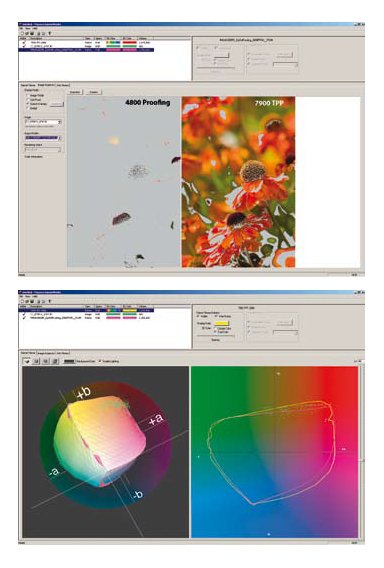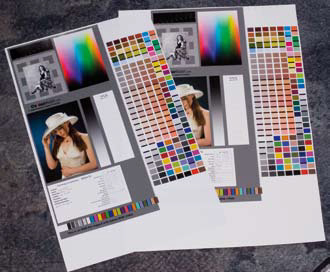articles/Printers/epsongamutboost-page4
Epson Gamut Boost - part 4 of 1 2 3 4
by Mike McNamee Published 01/10/2008

For a more searching test we also checked out both the flower image and profiles using Monaco Profiler. This enables us to overlay gamuts, images and pixel 'star fields'. This is a more sophisticated test than soft proofing in Photoshop. The gamut warning view shows the 4800 variant to be spectacularly out of gamut (ie all flagged in grey) but the 7900 onto Traditional Photo Paper does quite a bit better.
Commentary
The screen grabs and data should be treated with due caution for although they show the gamut of the 7900 is measurably greater than the previous ink sets, this does not make 3800/4800 prints poor! Such is the accommodating nature of the eye that these subtle variations would pass unnoticed. However, there are two business models where the extra capability might be exploited. If being able to say to an artist, 'I can reproduce your art with more colour precision than my competitors', brings in more business, you are onto a winner. If you are contract proofing where spot colours are going to be measured and perhaps contractually binding, then you are on to a winner.
Perversely for contract proofing of CMYK output the additional colours do not help, indeed in many cases the RIP will remove anything other than C, M, Y and K from the equation.
The balance you must find therefore is between the additional cost of investment either as an upgrade or a first purchase, along with slight additional costs of having extra cartridges on your shelf, against the cost benefit to having the greater gamut. There is a twist though. The 7900 and 9990 can also be supplied with a built-in spectrophotometer. While this is good for profiling thirdparty media, the main advantage is that you can proof a job, then audit it with the spectro and print the target and the error data, a requirement for FOGRA, UGRA and GRACoL contract proofing. At the time of writing we were unsure if the spectro and target complied with the latest standards for this.

We did, of course, make real prints! Dmax of the new ink set was 2.31 and the metamerism was 0.9 Lab points, both excellent values. The Granger Charts were very smooth. The print onto Epson Velvet Fine Art was particulary smooth and very accurate indeed at 2.3 ?2000 out of the box!
In case you think that the 7900 and 990 are just pretty colours, we ought to highlight the other features that come along with them. The number of print heads has been doubled so that 40m2/hr is possible in terms of output. The full feature list is as follows:
11-colour Epson UltraChrome HDR ink set, expanding UltraChrome K3 with Vivid Magenta by adding Orange and Green in 11 individual, high capacity 350ml or 700ml cartridges
10-channel Epson MicroPiezo TFP print head for accurate and reliable imaging with the highest image quality Epson Variable-sized Droplet Technology for optimum speed, ink usage, efficiency and image detail
Optional Epson SpectroProofer technology powered by X-Rite spectrophotometer
Auto-switching of Matte and Photo Black inks
Epson new Look Up Table technology and super halftone technology for smooth gradations, less graininess and quality greyscale
Epson automatic nozzle check technology
Optimised throughput by use of high-speed rotary cutter
Overall
So far everything about the new HDR ink set and printers looks good, once again Epson have pushed up the bar. This latest step is not about proofing precision for CMYK, but about expansion of the colour range for those colours that have previously been out of reach. Exciting times, we can't wait to get onto a real machine and give it the once over! Prices for the four new printers have yet to be announced.
Please Note:
There is more than one page for this Article.
You are currently on page 4 Contact Mike McNamee
1st Published 01/10/2008
last update 09/12/2022 14:53:56
More Printers Articles
There are 16 days to get ready for The Society of Photographers Convention and Trade Show at The Novotel London West, Hammersmith ...
which starts on Wednesday 14th January 2026





